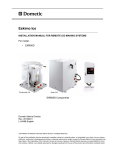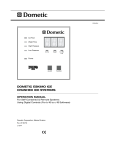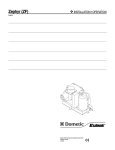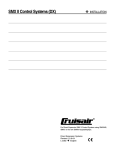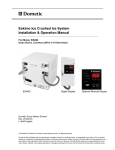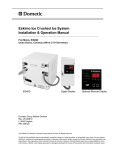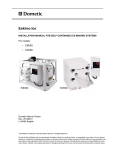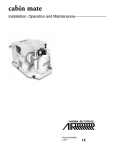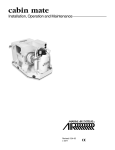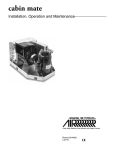Download Dometic Eskimo Ice Remote Ice Crushing System Troubleshooting guide
Transcript
Eskimo Ice Remote Ice Crushing System Installation & Operation Remote Ice Crushing System Revised: 6-21-06 L-2448B TABLE OF CONTENTS Maintenance INTRODUCTION Seawater System .............................................................. 11 Refrigerant Gas ................................................................ 11 Compressor ...................................................................... 11 Auger Motor ...................................................................... 11 Auger Gearbox ................................................................. 11 Water Reservoir ................................................................ 11 Water Filter ....................................................................... 12 Evaporator Cleaning ........................................................ 12 Winterizing the System ..................................................... 12 Drawings and Diagrams .................................................... 3 Ice Making and Refrigeration Basics 3 Ice Maker Components ...................................................... 3 INSTALLATION Choosing the Correct Voltage Equipment ......................... 5 Installing the Condensing Unit 11 5 Selecting the Site ............................................................... 5 Site Location Check List .................................................... 5 Mounting the Condensing Unit .......................................... 5 Installing the Auger Unit Troubleshooting Guide 12 Limited Warranty Periods 16 Description of Figures and Diagrams 17 Site Location Check List .................................................... 5 Mounting the Auger Unit .................................................... 5 Installing the Ice Level Sensor ........................................... 6 Installing Ice Delivery Hose ............................................... 6 Installing the Refrigerant Linesets 6 Connecting the Quick Connect Fittings ............................. 6 Installing the Feed Water System Water Quality ...................................................................... 7 Use of Saltwater as the Evaporator ................................... 7 Installing the Seawater Cooling System 7 Through-Hull Inlet Fitting .................................................... 7 Seacock .............................................................................. 7 Strainer ............................................................................... 7 Seawater Pump .................................................................. 8 Required Seawater Flow Rate ........................................... 8 Manifolds ............................................................................ 8 Overboard Discharge ......................................................... 8 Seawater Piping ................................................................. 8 Bonding .............................................................................. 8 Pump Relay ........................................................................ 8 Installing the Control Panel 8 OPERATION Start-up Check List Servicing the System 9 10 Refrigerant ........................................................................ 10 R134a Tools ...................................................................... 10 Constant Pressure Valve (CPV) ....................................... 10 Quick Connect Fittings (QC) ............................................ 10 Recharging the System 10 System shutdown ............................................................. 10 Evacuate Refrigerant ....................................................... 10 Charging the System ........................................................ 11 Setting the Constant Pressure Valve (CPV) .................... 11 Constant Pressure Valve (CPV) Replacement ................ 11 Copyright 2006 Dometic Environmental Corporation, All Rights Reserved - Every precaution has been taken in the preparation of this manual to insure its accuracy. However, Dometic Environmental Corporation assumes no responsibility for errors or omissions. Neither is any liability assumed for damages resulting from the use of this product and information contained herein. L-2448B 2 Y English INTRODUCTION Drawings and Diagrams WARNING The figures, drawings, or diagrams that are referenced in this manual can be found directly after the warranty section. In addition, some equipment may be shipped with specific installation sheets or wiring diagrams that may supercede the information located in this manual. Dometic reserves the right to update or change any information located herein at any time and without prior notice. This manual contains essential safety information concerning the safe and proper installation, operation, and maintenance of your ice making system. It is very important that you read and understand the contents of this manual thoroughly before installing or using the equipment. You should keep this manual on your boat for future reference. Failure to follow Dometic approved installation, start-up, operation, and troubleshooting procedures will void the warranty. If there are any statements in this manual that you do not understand, contact the Dometic Service Department or your local dealer for assistance. Ice Making and Refrigeration Basics Phone 804-746-1313 or 954-973-2477 (8am-5pm US Eastern Time), Fax 804-746-7248 or 954-979-4414, or email [email protected]. To produce crushed ice, heat must be moved from the ice making water source to the seawater condensing medium. The condensing unit contains both the compressor and condenser coil. The compressor adds pressure to the refrigerant gas, which causes an increase in temperature. The condenser coil removes heat and condenses the refrigerant gas into liquid. The liquid is pumped to the expansion device which lowers the pressure and allows the refrigerant to expand in the evaporator. When the refrigerant expands in the evaporator, it actually boils from a liquid to a gas. This change of state allows for a large energy exchange. After the refrigerant is fully boiled off into a gaseous state, it flows back to the compressor again. NOTICE Your ice making system uses the refrigerant R134a. Federal law forbids the intentional release of refrigerant gas to the environment. You should make certain that any field service is performed by a specialist with the proper equipment to prevent loss of refrigerant during servicing. DANGER The equipment referenced in this manual operates on 115 or 230 volts AC. Such voltages can be lethal, therefore, proper care must be taking during installation, operation, and servicing to prevent injury or loss of life. The evaporator in the ice maker allows cold refrigerant gas to remove heat from the water. As the water freezes onto the wall of the evaporator shell, it is scraped off by the auger, and pushed to the box. Ice Maker Components DANGER The system consists of two main components: the condensing unit and the auger unit. They are connected by copper linesets or flexible lines. Other parts include the control panel, seawater system, and ice level sensor. The equipment referenced in this manual operates with compressed refrigerant at high pressures. Proper care must be taken during installation, operation, and servicing to prevent injury or loss of life due to improper procedures. Condensing Unit (Figure 1) All units have R134a compressors, water-cooled condensers, a receiver/filter/drier, an accumulator, and a sight glass/moisture indicator. The condensing unit also has the logic control/electrical component box (control box) attached. The control box is attached to the condensing unit by an eight foot cable. It has plugand-play electrical connections to the auger unit and control panel. The control box may be remotely mounted, but must be mounted in the same orientation as when it was shipped. The unit comes with quick connect refrigerant fittings and is pre-charged with refrigerant from the factory. DANGER This equipment is not ignition protected per CFR 183.410 and may not be installed in areas that may be exposed to flammable gases. L-2448B Introduction 3 Y English Auger Unit (Figure 2) Freshwater Supply The auger unit contains the evaporator barrel, auger rotor, gearbox, motor, water reservoir, and expansion device. The unit comes with quick connect refrigerant fittings and is pre-charged with refrigerant from the factory. The unit has plug-and-play electrical connections to the control box and the ice level sensor. Freshwater supply for ice making should be provided via the ¼" male flare fitting on the auger unit. Provide water with pressure of at least 15 PSI. An in-line water filter is required to help prevent clogging of the needle valve in the water reservoir. Refrigerant Charge Control Panel (Figure 3) The condensing unit, the auger unit, and the linesets are all pre-charged with the correct amount of R134a refrigerant. No charge adjustment should be necessary upon installation. The control panel contains the system function switch as well as system indicator lights. It is a user interface that enables a visual indicator of system activity, such as whether the system is running or has a fault. Sight Glass/Moisture Indicator (Figure 1) Linesets A sight glass is provided on the condensing unit to provide quick access to a couple of pieces of system information. The sight glass will provide visual identification of refrigerant charge status (empty or full.) The sight glass also houses a moisture indicating element which can help in troubleshooting. Linesets are generally made of copper tubing which is connected to the auger at one end and the condensing unit at the other. The liquid line is ¼" copper tubing, while the suction line is ½" copper tubing. The suction line comes pre-insulated to prevent frost. Flexible sections are available where one part moves in relation to another, such a lifting deck. Quick Connect Fittings (Figure 1) The quick connect (QC) fittings allow for all parts of the unit to be factory evacuated and precharged with refrigerant. They allow for easy and quick installation in the field. They are polarized so they can’t be hooked up incorrectly. They can be reused over time and again if the unit is ever relocated. System Controls The ice maker system is controlled by logic that is programmed into the SmartRelay. The SmartRelay controls all operations of the system, and gives visual indications of activity to the user via the control panel. The logic system takes into account low refrigerant pressure, high refrigerant pressure, low feedwater for ice making, blocked ice delivery system, and auger motor start error. The control box contains a System Reset switch for use when the control locks out due to a sustained fault. Constant Pressure Valve (Figure 4) The constant pressure valve is used as the expansion valve of the refrigerant system. It allows high pressure liquid to become low pressure liquid and start the refrigeration process. The constant pressure valve is very simple and reliable, and provides for a constant system pressure over a wide range of ambient and seawater temperatures. The valve pressure is set at the factory, and generally needs no field adjustment. The recommended pressure is 9-10 PSI. Ice Box The ice box where the ice is to be dumped should be insulated, if possible, with at least 2" of insulation to help keep the ice as long as possible. It is also helpful to install a drain at the opposite end of the box from the ice input. Misadjustment of the valve can cause reduced ice production, damage to components, and voiding of the warranty. Seawater System (Figure 1) The cupro-nickel coaxial tube design allows for efficient exchange of heat between the seawater and the hot refrigerant. The condensing unit may be hooked up to either its own single-station pump, or to a larger, multi-station pump via a pump relay box. The seawater system should consist of a through-hull fitting, seacock, strainer, seawater pump, seawater hose, and overboard discharge. L-2448B Introduction 4 Y English INSTALLATION This section covers installation procedures for your ice making system. Please read the manual completely before attempting to install any equipment. Use screws or bolts through the holes in the four corners of the pan to secure the unit. You may remove the pan and turn to get the proper orientation of the drain stub. Choosing the Correct Voltage Equipment Do not remove any covers, caps, or fittings that may expose any wiring or refrigerant until you are ready for that step of the installation. The voltage rating of a unit is a nominal rating. The voltage in a given location may be higher or lower by as much as 10% and the system will still operate correctly. For example, at 60 Hz, you will sometimes see 110 VAC to 120 VAC, or 208 VAC to 240 VAC. In a 50 Hz environment, common voltages range from 220 VAC to 240 VAC. If you decide to remotely mount the control box, be sure to mount in the same orientation in which the unit was shipped. Failure to do so could cause system failure. When choosing your system, the voltage and frequency must be known. While this 60 Hz equipment can be run at 50Hz, it will experience a 17% drop in performance. When using this equipment on 50 Hz, the voltage must be the lower of the two voltages given (100 or 200) on the data plate due to buildup of heat in the motor. Installing the Auger Unit The auger is designed to be installed close to the ice box. This minimizes the amount of tubing between the box and auger, and minimizes the time required for ice to start entering the box. It also helps to reduce the amount of melting taking place in the hose and reduce the chance for ice clogging. The auger unit has an elbow on the top, right-hand side which is where the ice exits the auger itself. The elbow can rotate 360o to accommodate the location of the hose to the ice box. It is important that the elbow is oriented in an upward direction to allow water to re-enter the auger barrel instead of running to the ice box. Installing the Condensing Unit Selecting the Site Dometic ice making units are designed to be installed in any convenient location. The unit is normally located in the engine room or other machinery space, but can be located in living areas if necessary. The condensing unit will produce some condensation, so the drip pan is necessary. The space around the unit may be insulated to reduce noise if necessary. The unit is water cooled, and does not need ventilation. Site Location Check List • Choose a location as close to the ice box as possible • Orient the unit so that refrigerant, water, and electrical connections are accessible • Orient the unit so that the front and/or top cover may be removed for service and maintenance Site Location Check List • Adequate space for access to refrigerant, seawater, and electrical connections • Choose a substantial vertical surface, or a flat, horizontal surface • Accessible for service and maintenance • Do not place in an area of direct salt spray • Away from direct spray from engine air intakes or water washdown Mounting the Auger Unit • Flat, horizontal surface Orient the unit so that the refrigerant, water, and electrical connections are accessible. Plan for enough space in front of and on top of the unit for panel removal. Securely fasten to a sturdy vertical wall using the keyhole slots in the rear of the unit, or secure to a flat, horizontal surface using the tabs provided on the bottom of the unit. • Maximum refrigerant tubing run is 50 feet (15m) Mounting the Condensing Unit Orient the unit so the refrigerant, seawater, and electrical connections are accessible. Do not remove any caps, covers, or fittings until you are ready for that step of the installation. L-2448B Installation 5 Y English Installing the Ice Level Sensor Connecting the Quick Connect Fittings Use Figure 5 to determine placement for the Ice Level Sensor. The sensor must be located below the ice delivery hole and to the side, per Figure 5. Drill 23/32" hole for sensor. Use two lock nuts provided to secure sensor into hole. Use marine grade sealant around the hole if desired. Remember that the unit may have to be removed at some time. Route the cable to the auger unit, and plug into the matching plug. The linesets, auger and condensing unit all have quick connects (QC). QC fittings allow for connection and disconnection of the system with no loss of refrigerant. Route the lines directly to each unit, and approach the QC in a straight line. Do not try to screw fittings together which are not mated correctly, as doing so will destroy the fittings. Connect the fittings together in the following method: Installing Ice Delivery Hose • Lubricate the male fitting face and thread lightly with refrigeration grade oil. Figure 5 and 6 shows the proper ice delivery hose connection. The first step is to install the proper through-hull in the ice box (Figure 5). This through-hull must be large enough for the 1¼" ice hose to fit inside the fitting (use supplied part). It should be installed in such a manner as to provide (Figure 6): • Hand thread the nut of the female QC onto the male threaded QC by rotating the union nut clockwise. • Tighten the female thread connection with a wrench while holding the opposite coupling with a wrench. Exception: The male QC is held by a metal bracket at each unit, and does not need a wrench on it. 1) A continuous uphill route of travel from the auger unit (BEST) 2) A continuous route of travel, with only one high spot (GOOD) • Tighten each assembly to 35 ft. lbs. 3) A route of travel which includes one low spot and two high spots (ACCEPTABLE) • If you don’t have a torque wrench, then tighten each assembly until the fittings “bottom out.” Then use a marker to make a line on each coupling half hex. Turn with wrenches an additional 1/6 to ¼ turn to completely seal the assembly. The best routing provides for a level, but slightly upward rising hose from the auger toward the box, with very few bends. No bend should be tighter than a radius of 12". Insulate the full length of hose with 1 5/ 8" ID, ¾" thick wall insul-tube, minimum. Provide a ¼" hole for an air vent where instructed as in Figure 6. Do not block with insulation. If there are any dips in the hose, we suggest that you drill a ¼" hole in the hose for a water relief. While the water will not prevent ice flow, it could freeze in low ambient conditions, preventing ice delivery. Do not block the hole with insulation. Secure at each end with double hose clamps, so that the line will not get pulled out. In addition, PVC glue may also be used at the thru-hull end. Strap hose to bulkhead securely, keeping in mind that the hose will be much heavier once filled with ice. Be careful not to kink or crush hose, because any obstructions will prevent free flow of ice. IMPORTANT If fittings are cross-threaded together by not using the steps above, the fittings will be destroyed and the warranty voided. Installing the Feed Water System The feed water for the auger unit should be fresh water supplied by potable water system of the boat. Use of saltwater is not recommended because of the damage it causes to the components of the auger and evaporator barrel. Feed water should be supplied with pressure of at least 15psi. The water system must be able to supply at least 4 gallons per hour when the ice maker is operating. Use of an in-line filter just prior to the auger unit is required to remove sediment which may cause occlusion of the needle valve in the water reservoir, and to reduce scale buildup which will inhibit system performance, and may cause damage to the auger components. We suggest a filter that will remove dirt, rust, odor, and scale, such as Dometic Part #3150707. Dometic recommends that a shut-off valve be installed in the feedwater line, between the source and the filter, to help facilitate filter removal. Run copper tubing or equal from the water source to the auger unit, and connect with the supplied connection Installing the Refrigerant Linesets The refrigerant lines may run uphill, downhill, or sloping as necessary. They can have bends as necessary, but avoid sharp bends which could result in kinking of the tubing. Once connections are made, the suction line should be fully insulated from unit to unit. L-2448B Installation 6 Y English on the unit. Ensure that there are no leaks in the field installed portion of the system. The water reservoir has a float switch to ensure that the unit does not operate without water supply. without any dips of loops, and with only one high point in the system. This is called self-draining because all the water will drain out of the piping if the boat were taken out of the water. Whenever air gets into the system, which can happen in heavy seas or a sharp turn, it can become trapped in the pump. Because centrifugal pumps cannot pump air, water flow is lost. Water Quality No water which comes from municipalities is ‘pure’ water. Water from the water maker on board a vessel will come as close as you will probably see. The problem is that water contains suspended and dissolved solids. Pure water freezes first, leaving the solids to increase in concentration in the unfrozen water. Solids also bond to the evaporator wall during freezing, forming scale. Eventually, built up scale will shorten machine life. A filter should always be used, preferably one approved by Dometic for use with ice makers. The filter should be replaced at least twice yearly, or more often if the machine is used often. While filters will help clean the water, a yearly cleaning of the evaporator barrel is required, see the Maintenance section, under Evaporator Cleaning. A self-draining system will allow air in the piping to rise naturally through the pump and then be expelled. It will also make winterizing the system much easier. Figure 7 shows a properly plumbed system and some common mistakes. Through-Hull Inlet Fitting A separate through-hull fitting must be installed for each seawater pump. Do not attempt to draw water from an engine, generator, or other through-hull fitting. A scoop-type through hull should be installed facing forward, as far below the water line and as close to the keel as possible. Use of Saltwater as the Evaporator Saltwater use in the evaporator to make ice is not approved by Dometic, even though the machine can freezer salt water. Salt water is very corrosive in itself, plus it contains many more dissolved and suspended solids than freshwater. If you wish to have brine solution for your catch, we suggest sprinkling some salt over the ice in the catch box. USE OF SALTWATER IN ANY DOMETIC ICE MAKER WILL VOID THE WARRANTY! Drill a properly sized hole for the through-hull fitting. Bed the scoop with marine sealant designed for underwater use, and tighten the nut onto the throughhull to secure it. Seacock A full-flow seacock should be installed directly onto the through-hull fitting. Use Teflon tape or equivalent to seal the threads. The seacock must be accessible and easy to close in case of emergency, of to clean the strainer. Installing the Seawater Cooling System Strainer A seawater strainer must be installed between the seacock and the pump, and should be situated to provide easy access for cleaning. The strainer must be located vertically above the seacock and below the pump so any air that gets into the strainer can get out. The following installation instructions apply to ice maker units as well as general air conditioning units. Importance of a Self-Draining System A poorly plumbed seawater system is one of the most common installation problems on marine refrigeration and air conditioning. When water flow is lost, not only with the ice maker cease to produce ice, but the pump could be damaged from running with no water flow. Make sure the water flow through the strainer is in the correct direction. Some strainers have an arrow that shows correct flow direction. Mount the strainer to a bulkhead so it is properly supported before connecting hoses. Use Teflon tape or equivalent on pipe threads. When using a centrifugal seawater pump, it is imperative that the seawater piping be routed continually uphill from the through-hull to the condenser, then smoothly up or down to the overboard discharge, L-2448B Installation 7 Y English Seawater Pump • Use the correct size hose, fittings, and components. See Figure 9 for proper sizing. Note that the pump inlet piping (including through-hull and strainer) may need to be larger than the outlet pipe size. Do not use pump connections to determine hose size. Centrifugal pumps are not self-priming, and must be mounted so that they are below the heeled waterline in any given operating condition. The pump should be accessible for future service. Mount the pump so that the outlet is directed upward. The head on some pumps can be rotated to allow mounting on a vertical bulkhead, see Figure 8. Selfpriming pumps are available if the pump cannot be mounted below the waterline. • The “pump inlet” recommended pipe size includes all fittings and hose up to the pump connection (through-hull, seacock, strainer, hose, manifold). The “pump discharge” recommended pipe size includes all fittings and hose from the pump discharge up to the overboard discharge. Required Seawater Flow Rate The Dometic ice maker requires 2.5 GPM or 150 GPH of seawater flow for rated performance. Bonding Bond all metallic parts (through-hull, valves, strainer, manifolds, etc.) that are in contact with seawater to the vessels’ bonding system in accordance with ABYC standards. Items should only be bonded or grounded once. If an item is in contact with an electrically grounded part (pump, seawater condenser) then it should not be bonded again. Manifolds If a pump is serving multiple units, then a seawater manifold will be needed to supply water to all units. This can be as simple as a tee for two units, or a custom manifold for seven to eight units. It is very important to consider manifold orientation so that all units get their required flow. See Figure 9 for proper orientation tips. Pump Relay The pump relay is generally located in the engine room or mechanical space near the seawater pump, but can be mounted anywhere that is convenient and accessible. It must be in a dry location, away from water spray, with some room for heat dissipation. A manifold can also be used on the outlets of the units when using a single overboard discharge. Overboard Discharge Choose your pump relay based on the number of units that will be operating off one pump. Choose each trigger to reflect the voltage of the unit it serves. The polarity of the signal from the unit does not matter to the trigger, but the voltage is very important. The overboard discharge should be located between 1 and 2 inches (25-50 cm) above the waterline. This is to facilitate visual confirmation of water flow, but also to keep it close to the waterline to minimize splashing. If the overboard is located below the waterline, then a valve must be installed per ABYC guidelines. Seawater Piping Installing the Control Panel • Only use reinforced marine grade hose or other suitable piping (PVC, CPVC, cupronickel, or stainless steel). The control panel may be installed wherever desired, however, it may not be exposed to saltwater spray. The panel comes with a plug on the back. Use extension cables (purchased separately) to run between the panel and the control box. They may be extended up to 100'. Use the cutout dimensions provided in Figure 10. Route cable to control box on condensing unit, and plug into the mating connector. • Double clamp all hose connections. • Use only plastic, bronze, or stainless steel fittings (do not use brass). • Avoid loops or dips in all hose runs. • Make sure enough hose is used to allow for future removal of components. L-2448B Installation 8 Y English OPERATION This section of the manual refers to essential safe operation for all Dometic ice makers. For any operational problems, call your dealer, or our service department at 804-746-1313. • Watch for ice within five minutes of starting, plus approximately one minute for each foot of hose between the box and auger unit NOTE: The seawater pump should cycle automatically whenever the unit is running. Regularly check for seawater flow by observing the overboard discharge. If you do not observe any flow when the system is running, check for obstructions in the seawater cooling system. Start-up Check List A) Before you start the system • Check that all refrigerant connections are tightened per installation manual C) Control Operation • Check to make sure that all refrigerant lines are secured so as not to rub against other objects during operation • The control system works off pre-programmed logic to operate the condensing unit and auger unit within the assigned parameters. The logic uses sensors, timers, and counters to protect system components from failure due to loss of freshwater, loss of seawater, ice clogs, low refrigerant, or auger motor start failures. It also controls system operation based on ice bin level. • Ensure that all portions of the suction line, including connections, are insulated to prevent ice build-up • Confirm that electrical connections are correct and tight. • Make sure that the ice level sensor is mounted securely and the cable is routed safely. • Input and output starts at the control panel. The panel contains the system on/off switch, system running indicator light, pressure fault light, ice clog failure light, and the freshwater feed failure light. These indicators help determine system function, and failure mode, if one occurs. • Make sure that all units are mounted securely. • Check seawater connections to make sure that they have correct flow direction, and that all connections are tight. • System failures that result in sustained shutdown, as indicated by one of the red failure lights on the control panel, can be reset with the Reset switch on the control box at the condensing unit. If the Reset switch needs to be used, it is a good indication of an actual problem, not just a passing event. • Confirm that all metallic parts are bonded correctly • Make sure there are no loops or dips in the seawater system • Confirm that frequently accessed parts are accessible i.e. control box, constant pressure valve, refrigerant ports, etc. • Required events for sustained shutdown (in need of Reset switch operation) • Check ice delivery hose for insulation, air hole, and drain hole, if required. Make sure that the hose is securely fastened. 1) High pressure switch operation of three (3) times within 45 minutes. B) Starting the system 2) Low pressure switch operation of six (6) times within 45 minutes. • Turn on the designated circuit breaker for the unit, and also the one for the pump if it is on a separate breaker at the boat’s electrical panel 3) Freshwater feed fault each time level the fault occurs. • Open the seacock on the pump intake • Turn the switch on the ice maker unit to ‘ON’ 4) Ice clog indicator switch on ice discharge nozzle each time the fault occurs. • When the unit starts (after the two minute delay) watch the sightglass for flowing refrigerant 5) Auger motor start error each time the fault occurs. • Check the sightglass after 15 minutes to make sure that the indicator inside shows green (no moisture) NOTE: If system needs to be reset more than twice within one day, please have the system serviced. • Confirm that water is flowing through the overboard discharge L-2448B Operation 9 Y English Servicing the System This section contains information critical to correct servicing of this Dometic ice making system. Please read and understand all information before beginning. If you have any questions, please call Dometic at (804) 746-1313. Refrigerant Your Dometic ice making system contains R134a refrigerant, an environmentally friendly gas, which has no current phase-out date. R134a is a single component refrigerant and should never be charged in the liquid phase while the unit is running. The units contain enough refrigerant for operation when they are received. It should not need normal or seasonal recharging. R134a Tools You should use a dedicated R-134a gage set. This system uses the common automotive type quick connects for the gage connections. They help ensure L-2448B Operation 10 Y English Charging the System 6) Evacuate the system as described in “Evacuate Refrigerant, and recharge the system with the correct amount of R134a. 1) Remove line from vacuum pump, and connect to a bottle of R134a. The charge should be weighted in by placing the bottle on a refrigerant scale. 7) Set suction pressure as described in “Setting the CPV.” 2) Turn the bottle upside down, and purge the charge hose at the gage set. 3) Allow refrigerant to flow in the high side until the correct charge is reached. Disconnect refrigerant tank. Maintenance The periods and procedures given for maintenance and cleaning are guides only and should not to be construed as absolute or invariable. Cleaning especially will vary, depending on local water conditions (hard water, etc) and the ice volume produced. Setting the Constant Pressure Valve (CPV) 1) Start the system and run for 15 minutes. Observe the low pressure gage. The CPV should be adjusted to maintain approximately 9-10 PSI. Seawater System Check the seawater strainer daily. Remove any debris. If you are in waters where jellyfish or other debris is a real problem, you may find it necessary to add a strainer on the outside of the thru-hull fitting. Verify that all water connections are tight, and check for water flow from the overboard discharge. The centrifugal pump does not need any routine maintenance. 2) Turn valve adjustment knob clockwise (in) to raise pressure and counterclockwise (out) to lower pressure. Only make ¼ turn adjustments at the time, and allow three (3) minutes between adjustments for system to equalize. 3) Make sure that the valve is dry, and replace the cap on CPV, being careful not to disturb the setting by gripping the cap too tightly. Refrigerant Gas The refrigerant included in the system is adequate for the life of the system, and should not need routine or seasonal charging. If the need exists for routine charging, then look for a refrigerant leak that needs repair. 4) Remove gage set and replace service port caps. Constant Pressure Valve (CPV) Replacement Compressor The CPV is a very simple and durable metering device. Often small blockages can be cleared by turning the adjustment knob completely in, then back out. In the unlikely event that the CPV is blocked or the diaphragm ruptured, it can be replaced as follows: The compressor has no user serviceable parts, and is lubricated constantly during operation. Auger Motor The auger motor is permanently lubricated, and needs no regular maintenance. 1) Recover refrigerant as described in “Evacuate Refrigerant.” 2) Remove CPV from the auger. Auger Gearbox 3) Remove the ¼" liquid line by loosening the flare nut. Thread sealant has been applied to the flare threads, so some extra force may be required to loosen. The gearbox comes pre-filled with lubricant, and should not need regular maintenance. 4) Connect the CPV to the auger. We recommend using a threadlocker, such as LocTite 545 or equivalent, on the threads ONLY. Tighten as you would a flare fitting. Do not overtighten. Water Reservoir Quarterly clean and flush the water reservoir. Depress the float to ensure that a full stream of water enters the reservoir. 5) Connect the ¼" line to the new CPV. We recommend using a threadlocker, such as LocTite 545 or equivalent, on the threads ONLY. L-2448B Operation 11 Y English Water Filter Winterizing the System Change the filter at least twice per year, or every 1500 gallons, whichever comes first. The correct filter will help prevent clogging of the float valve, and scale buildup within the evaporator chamber. We suggest Dometic Part #3150707. Close the seacock and remove the inlet hose from the condensing unit. Allow all water to drain from the system. Loosen the screws on the pump head to allow water to drain from the pump. Cutoff feedwater supply, and drain at the auger unit. Be sure to remove water from the water reservoir inside the auger unit. You may also add some non-toxic antifreeze to the water reservoir. Evaporator Cleaning Once per year, the evaporator should be cleaned. This should be carried out by an authorized service agency. The following steps should be used: Troubleshooting Guide 1) Shut off the water supply to the ice machine Before calling for service, review this list. It may save time and expense. This list contains potentially common occurrences that are not a result of defective workmanship or materials. If you still need service after trying these procedures, call you local dealer, or the Dometic service department at (804)746-1313. 2) Disconnect clear tubing from bottom evaporator, and drain all water from the evaporator. Reconnect the tubing. 3) Prepare cleaning solution, mix 8 ounces of Scotsman Ice Machine Cleaner, or equivalent, with two quarts of hot water. If other solution is used, follow instructions on bottle. Problem: Unit does not operate at all 4) Remove the cover to the water reservoir. Potential Solution: 5) Slowly pour the cleaning solution into the reservoir. 1) Check for tripped breaker or blown fuses 6) Turn the machine to the ON position. 2) Significantly low voltage to unit 3) Misconnected or loose plugs or wiring 7) Continue pouring cleaning solution into the reservoir, maintaining the level just below the overflow, while the machine makes ice. 4) System switch in the ‘Off’ position 5) Ice level is high enough. Move ice around box. 8) Continue ice making until all of the solution is used up, and the reservoir is empty. Problem: Pressure fault light on. 9) Turn the machine to the OFF position. Potential Solution: 10) Wash and rinse the water reservoir. 1) Check seawater system for clogs or faulty pump 11) Open the water supply to the ice maker 12) Turn the machine to the ON position 2) Faulty pump relay trigger at relay station (if pump is used for more than one unit). Replace trigger. 13) Let the machine make ice for AT LEAST 15 minutes to flush out any remaining cleaning solution. 3) Low refrigerant charge, have a certified technician check. 14) Remove all ice from the ice bin, do not use any of the ice produced during the cleaning cycle. 4) Improperly set Constant Pressure Valve. Set per instructions in “Setting the CPV.” 15) Use hot water to rinse the ice bin. Problem: Ice Clog fault light on WARNING Potential Solution: Ice Machine Cleaners use strong acids. Read and follow all instructions and warnings on the solution container that you use. 1) Check for obstruction at the ice discharge in the ice bin 2) Check for frozen ice delivery hose 3) Check for kinks in the ice delivery hose 4) Check for auger motor failure L-2448B Operation 12 Y English Problem: Feedwater fault light on Problem: Oil in auger assembly drain pan Potential solution: Potential Cause/Solution 1) Check for water pressure in boat’s potable water system 1) Water in gear reducer has raised level of the oil so that it can run out of the weep hole on the top of the gear housing. It may occur due to: 2) Check for a valve that has been turned off i. Leaking water seals in the evaporator/auger assembly, replace seals. 3) Check for a clogged feedwater filter. 4) Check for a clogged needle valve in the water reservoir. ii. Loose or missing drain hose on weep hole, which might allow condensate to leak into the weep hole. Problem: Ice delivery volume seems inadequate Potential Cause/Solution: 1) High seawater temperature 2) High feedwater temperature 3) Low seawater flow, check pump and strainer 4) Drivemotor weak, replace motor 5) Corroded or stained auger due to water condition, clean and/or replace assembly 6) Inlet water filter/strainer partially clogged, replace filter 7) Loss of refrigerant charge, consult trained technician Problem: Water Leaks Potential Cause/Solution: 1) Defective Water seal, replace seals 2) Water level in reservoir too high, adjust float Problem: Excessive noise or chattering from evaporator/auger assembly Potential Cause/Solution: 1) Mineral or scale deposit on auger and evaporator walls. Clean evaporator 2) Poor water supply, check for fouled filter or float valve 3) Gear reducer assembly loose on mounts 4) Gearmotor end-play of worn bearing, replace worn part L-2448B Operation 13 Y English Owner’s Limited Warranty As hereinafter described, Dometic Environmental Corporation limits the duration of any implied warranty to the duration of the underlying express warranty and also disclaims any liability for consequential or incidental damages arising from any application, installation, use or malfunction of any warranted product. Section I Section II What does the Limited Warranty cover? What does this Limited Warranty not cover? This Warranty Shall Not Apply to: Products manufactured by Dometic Environmental Corporation (Dometic) are under limited warranty to be free from defects in workmanship or materials under normal use and service with the obligation of Dometic under this limited warranty being limited to replacing or repairing any component(s) which shall disclose defects within the time limits defined in Section III and which, upon examination by Dometic, shall appear to the satisfaction of Dometic to be defective or not up to specifications. This Limited Warranty is made in lieu of all other express warranties, obligations, or liabilities on the part of Dometic. In addition, Dometic shall not be responsible for any incidental or consequential damages. In those instances in which a cash refund is made, such refund shall effect the cancellation of the contract of sale without reservation of rights on the part of the purchaser. Such refund shall constitute full and final satisfaction of all claims which purchaser has or may have against Dometic due to any actual or alleged breach of warranty, either express or implied, including, without limitation, any implied warranty of merchantability or fitness for a particular purpose. Some states do not allow the exclusion or limitation of incidental or consequential damages so the above limitation may not apply to you. The terms and conditions of this warranty shall be governed by the laws of the Commonwealth of Virginia. The Dealer is not an agent for Dometic except for the purpose of administering the above warranty to the extent herein provided, and Dometic does not authorize the dealer or any other person to assume for Dometic any liability in connection with such warranty, or any liability or expense incurred in the replacement or repair of its products other than those expressly authorized herein. Dometic shall not be responsible for any liability or expense except as is specifically authorized and provided in this section. Failures resulting from improper installation or use contrary to instructions. 2. Failures resulting from abuse, misuse, accident, fire, or submergence. 3. Any part manufactured by Dometic which shall have been altered so as to impair its original characteristics. 4. Any parts which fail as a result of misuse, improper application or improper installation. 5. Items not manufactured by Dometic, i.e., items which are purchased from another manufacturer and supplied as received by Dometic without alteration or modification except as any part of an Dometic-manufactured unit or component. 6. Components or parts used by or applied by the purchaser as an integral part of products not manufactured by Dometic. 7. Warranty does not cover damage to components that comprise a Custom Wrapped Box Evaporator refrigeration system (aka: catch boxes, fish boxes, etc.) when the box is installed in such a way that the customer can move it. These damages may include, but are not limited to: crimped refrigerant linesets (copper tubing or flexible linesets), refrigerant leaks, moisture ingression into the refrigeration system, subsequent damage to condensing unit from being operated with low refrigerant charge or moisture in the system, broken refrigerant connections, broken thermostat sensors, and/or broken constant pressure valves. Installation and application of Dometic components is not warranted by Dometic because Dometic has no control or authority over the selection, location, application, or installation of these components. Section III Dometic reserves the right to improve its products through changes in design or material without being obligated to incorporate such changes in products of prior manufacture, and to make changes at any time in design, materials, or part of units of any one year's model, without obligation or liability to owners of units of the same year's model of prior manufacture. What is the period of coverage? See the Limited Warranty Periods, document # L-0694, for the period of coverage. All Dometic components bear a data plate on which there are model and serial numbers. The serial number is date coded. To determine whether or not any Dometic component is in warranty, proceed as follows: This warranty gives you, the purchaser, specific legal rights, and you may also have other rights which vary from state to state. You also have implied warranty rights, including an implied warranty of merchantability, which means that your product must be fit for the ordinary purposes for which such goods are used. The duration of any implied warranty rights is limited to the duration of the express warranty as found in Section III. Some states do not allow limitations on how long an implied warranty lasts, so the above limitation may not apply to you. L-2448B 1. 1. 14 Determine the manufacture date of the component from the serial number on the data plate. If you are not familiar with the date code, write or call the Dometic Customer Service Department at (804)746-1313, to obtain the manufacture date. Y English WARNING The hours of the Customer Service Department are 8:00 am 5:00 pm (USA, Eastern Time Zone) Monday through Friday excluding holidays. Dometic Environmental Corporation (Dometic) manufacturers of Cruisair, Dometic Auxiliary A/C, Dometic Refrigerators and Freezers, Eskimo Ice, Grunert, Marine Air, and Sentry products, makes the following safety warnings concerning the application, installation, use and care of its products. Although these warnings are extensive, there may be specific hazards which may arise out of circumstances which we have not outlined herein. Use this as a guide for developing an awareness of potential hazards of all kinds. Such an awareness will be a key factor in assuring your SAFETY and comfort. 2. It is possible that there might exist a considerable time lag between the date a component is manufactured and the date it is put in service. In such instances, the date of manufacture could indicate that the item is out of warranty. However, based on the date the equipment is first put in service, the item may still be covered by the Dometic warranty described in Section I. For proof of date put in service, Dometic will require a copy of the bill of sale of the Dometic equipment from the installer or new boat dealer to the original owner. ELECTRICITY - Many Dometic products operate on 115, 230 or 440 volt AC power. Such voltages can be LETHAL; therefore, the chassis, cabinets, bases, etc., on all components must be grounded together and connected to the vessel's grounding system. Sparks can occur as switches, thermostats and relays open and close in the normal operation of the equipment. Since this is the case, ventilating blowers for the removal of hazardous fumes or vapors should be operated at least 5 minutes before and during operation of any Dometic product or group of Dometic products. All electrical connections must be covered and protected so accidental contact cannot be made by persons using the equipment, as such contact could be LETHAL. Section IV ELECTROLYSIS - Electrical leakage of any component can cause electrolytic deterioration (electrolysis) of thru-hull components which could result in leakage serious enough to sink a vessel which could result in loss of life. All Dometic components must be kept clean and dry and checked periodically for electrical leakage. If any electrical leakage is detected, the component should be replaced or the fault causing the leakage corrected before the component is put back into service. How do you get service? Please Read the following Warranty Procedure. WARRANTY PROCEDURE GAS - Dometic Air Conditioning and Refrigeration components utilize R-22 (Chlorodifluoromethane), R134a refrigerant (Tetrafluoroethane), R-407C (which contains Diflouromethane [HFC-32], Pentafluoroethane [HFC125], and 1.1.1.2 -Tetrafluoroethane [HFC134a]), R404A (R125/R143a/R134 [44%/52%/4%]), or R417a, which are non-toxic, non-flammable gases; however, these gases contain no oxygen and will not support life. Refrigerant gas tends to settle in the lowest areas of the compartment. If you experience a leak, evacuate all personnel, and ventilate area. Do not allow open flames in the area of leaks because refrigerant gas, when burned, decomposes into other potentially LETHAL gases. Refrigerant components operate at high pressure and no servicing should be attempted without gloves, long-sleeved clothing and eye protection. Liquid refrigerant gas can cause severe frost burns to the skin and eyes. If the failure of a Dometic component is determined to be covered under the Dometic warranty and the time in service is determined to be within the warranty time limit, the owner has the following three options: 1. Preferred option: Have a Dometic authorized Servicing Dealer perform the work needed. The customer should call Dometic's Service Department for a recommendation as to the closest dealer. If the customer already knows an authorized servicing dealer, the dealer should be contacted directly. 2. VENTILATION - To cool or heat air, Dometic Air Conditioning and Refrigeration components are designed to move air through a heat exchanger by a blower or propeller fan. This design necessarily produces a suction on one side of the air handling component and a pressure on the other side. Air handling components must be installed so that the suction-pressure action does not: (1) pressurize an area to the extent that structural failure occurs which could cause harm to occupants or bystanders, or (2) cause a suction or low pressure in an area where hydrogen gas from batteries, raw fuel vapor from fuel tanks, carbon monoxide from operating propulsion engines, power generators or heaters, methane gas from sewage holding tanks, or any other dangerous gas or vapor could exist. If an air handling unit is installed in such a manner that allows potentially lethal gases or vapors to be discharged by the air handling unit into the living space, this could result in loss of life. If the customer contacts Dometic's Service Department for a Servicing Dealer and Dometic has no one in that particular area, Dometic will authorize the use of a local service company and Dometic will work with the local company to assist in any way possible. 3. The customer may send his equipment back to the factory to have the repair work done. Dometic will make every effort to return the equipment to the customer within a three week time period. If the claim represents a legitimate warranty problem, Dometic will pay the freight both ways. Dometic prefers option one and two, if at all possible. Maximum protection against the introduction of dangerous gases or vapors into living spaces can be obtained by providing living spaces which are sealed from all other spaces by use of airtight bulkheads and decks, etc., and through the introduction of clean air into the living space. Bear in mind that the advent of air conditioning, whether it be for cooling or for heating, naturally leads to the practice of closing a living space tightly. Never close all windows and doors unless auxiliary ventilating systems, which introduce clean outside air into the living space, are used. Always leave enough window and door openings to provide adequate ventilation in the event potentially lethal gases or fumes should escape from any source. The customer may contact the Dometic Service Department at (804) 746-1313. CONDENSATE - All cooling units produce water condensate when operating on the cooling cycle. This water must be drained from the cooling unit overboard. If condensate is allowed to drip on a wooden structure, rotting or decay and structural failure may occur which could result in loss of life. If condensate is allowed to drip on electrical components, deterioration of the electrical components could result in hazardous conditions. When an air conditioning system is in operation, condensate drains may be subjected to negative pressure. Always locate condensate drains as far as possible from points where engine waste and other dangerous gases are exhausted so no such dangerous gases can be drawn into the condensate drains. Warning L-0123 L-2448B Never sleep in a closed area on a boat when any equipment, which functions as a result of the combustion of a volatile fuel, is in operation (such as engines, generators, power plants, or oil-fired heaters, etc.). At any time, the exhaust system of such devices could fail, resulting in a build-up of LETHAL gases within the closed area. Warning Revised: 6-5-06 Revised: 6-5-06 15 Y English Limited Warranty Periods Please read and keep this document with your important paperwork. Use it as a reference in the future. If you have any questions, please contact the Dometic Environmental Corporation Service Department at (804)746-1313 for clarification. Note: Any model or replacement part that has been installed due to a warranty failure will carry only the remainder of the original warranty. All warranties begin when the customer takes possession of the equipment. The warranty is extended to all owners of the equipment commencing the date the original owner takes possession of it. Proof of original purchase may be required. Fuses and MOV’s are used as safety devices to protect Cruisair equipment against over-current conditions caused by lightning or inductive switching environments. These are not covered under warranty. We reserve the right to change our warranty policies and procedures as well as our warranty allowances without notice. Cruisair Direct Expansion (DX) and Modulating Systems Ice Makers, Remote and Self-Contained • New installation of an entire Self-Contained Ice Maker • New, complete system installation using any member of the SMX family. 1 year warranty including Parts and Labor, including water pump. The warranty includes the pump. • New installation of an entire Remote Ice Maker, including condensing unit, remote display, auger unit, linesets 2 year warranty including Parts and Labor 1 year warranty including Parts and Labor, including water pump. • New, complete system installation using an electro-mechanical control (3-knob). • New installation of an Remote Ice Maker Auger and Condensing unit only, with linesets done by others i.e. not Eskimo precharged linesets The warranty includes the pump. 1 year warranty including Parts and Labor 1 year warranty including Parts and Labor on mechanical and electrical parts of the auger and condensing unit only. • New, complete model sold as a partial system retrofit to an existing system. Includes SMX family. • New complete component sold as a partial system retro-fit to an existing Eskimo system 1 year warranty including Parts and Labor 1 year warranty including Parts and Labor on new component only. Cruisair Tempered Water Note: Use of saltwater as feedwater to make ice will void warranty on the auger section of the unit. • New, complete system installation using any member of the SMX family. 2 year warranty including Parts and Labor Sentry Battery Chargers NOTE: Excludes pump which has a 1 year warranty • New SM and FR series installation. • New, complete model sold as a partial system retrofit to an existing system. 2 year warranty including Parts and Labor Includes SMX family. • New G-series installation. 1 year warranty including Parts and Labor 1 year warranty including Parts and Labor Refrigerators/Freezers/Fish Boxes Replacement Parts The below warranty periods do not apply to systems that are installed as described in Section II, item #7, of the Owner’s Limited Warranty, document # L-0123. • Replacement parts and components Example: A-509, 40401-30. • New installation of entire system including condensing unit, line sets, evaporator, etc. • Replacement Compressors for other than Tempered Water Systems - example: R3101-16T, DX equipment - installed in an existing Cruisair system or a competitor’s system. 90 day warranty, Parts only 1 year warranty including Parts and Labor 1 year warranty including Parts and Labor • New complete model sold as a partial system retrofit to an existing Cruisair system. • Replacement compressors for Tempered Water - example: 30130-36 installed in an existing Cruisair system. 1 year warranty including Parts and Labor 1 year warranty including Parts and Labor • New installation of condensing unit only, with line sets, evaporators, etc. done by others i.e. not Cruisair pre-charged line sets and evaporators. • A Tempered Water compressor - example: 30130-36 installed with competitor’s equipment. 1 year warranty including parts and labor on mechanical and electrical parts of condensing unit only. 90 day warranty, Parts only Revised: 6-2-06 L-0694 L-2448B 16 Y English DESCRIPTION OF FIGURES AND DIAGRAMS Figure 1 – Condensing unit Figure 2 – Auger unit Figure 3 – Control Panel Figure 4 – Constant Pressure Valve Figure 5 – Photoelectric Eye Location Figure 6 – Ice Delivery Hose Routing Figure 7 – Seawater Piping Recommendations Figure 8 – Pump Head Orientation Figure 9 – Seawater Manifold Orientation Figure 10 – Cutout Dimensions for Control Panel Figure 11 – Complete System Hookup Diagram Figure 12 – 120VAC System Wiring Diagram Figure 13 – 240VAC System Wiring Diagram Figure 14 – Condensing unit diagram Figure 15 – Auger unit diagram L-2448B 17 Y English Figure 1 – Condensing unit Figure 4 – Constant Pressure Valve Seawater Condenser Sight Glass Quick Connects Figure 5 – Photoelectric Eye Location Figure 2 – Auger unit Front View Figure 3 – Control Panel System Running Ice Delivery Fault Feedwater Fault Pressure Fault System Power L-2448B 18 Y English Figure 6 – Ice Delivery Hose Routing L-2448B 19 Y English Figure 7 – Seawater Piping Recommendations Figure 8 – Pump Head Orientation L-2448B Figure 9 – Seawater Manifold Orientation 20 Y English Figure 10 – Cutout Dimensions for Control Panel Figure 11 – Complete System Hookup Diagram L-2448B 21 Y English Figure 12 – 120VAC System Wiring Diagram L-2448B 22 Y English Figure 13 – 240VAC System Wiring Diagram L-2448B 23 Y English Figure 14 – Condensing unit diagram L-2448B 24 Y English Figure 15 – Auger unit diagram L-2448B 25 Y English L-2448B 26 Y English L-2448B 27 Y English Dometic Environmental Corporation 2000 N. Andrews Ave. Ext. • Pompano Beach, FL 33069-1497 USA • Phone: 954-973-2477 • Facsimile: 954-979-4414 P.O. Box 15299 • Richmond, VA 23227-0699 USA • Phone: 804-746-1313 • Facsimile: 804-746-7248 Website: www.EskimoIceMachine.com • Email: [email protected] L-2448B




























